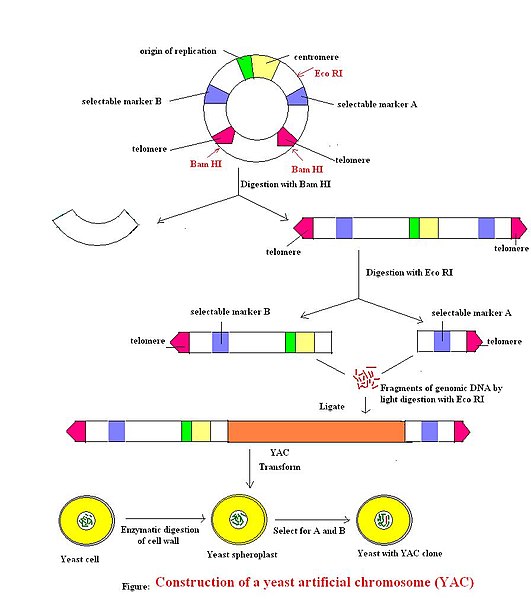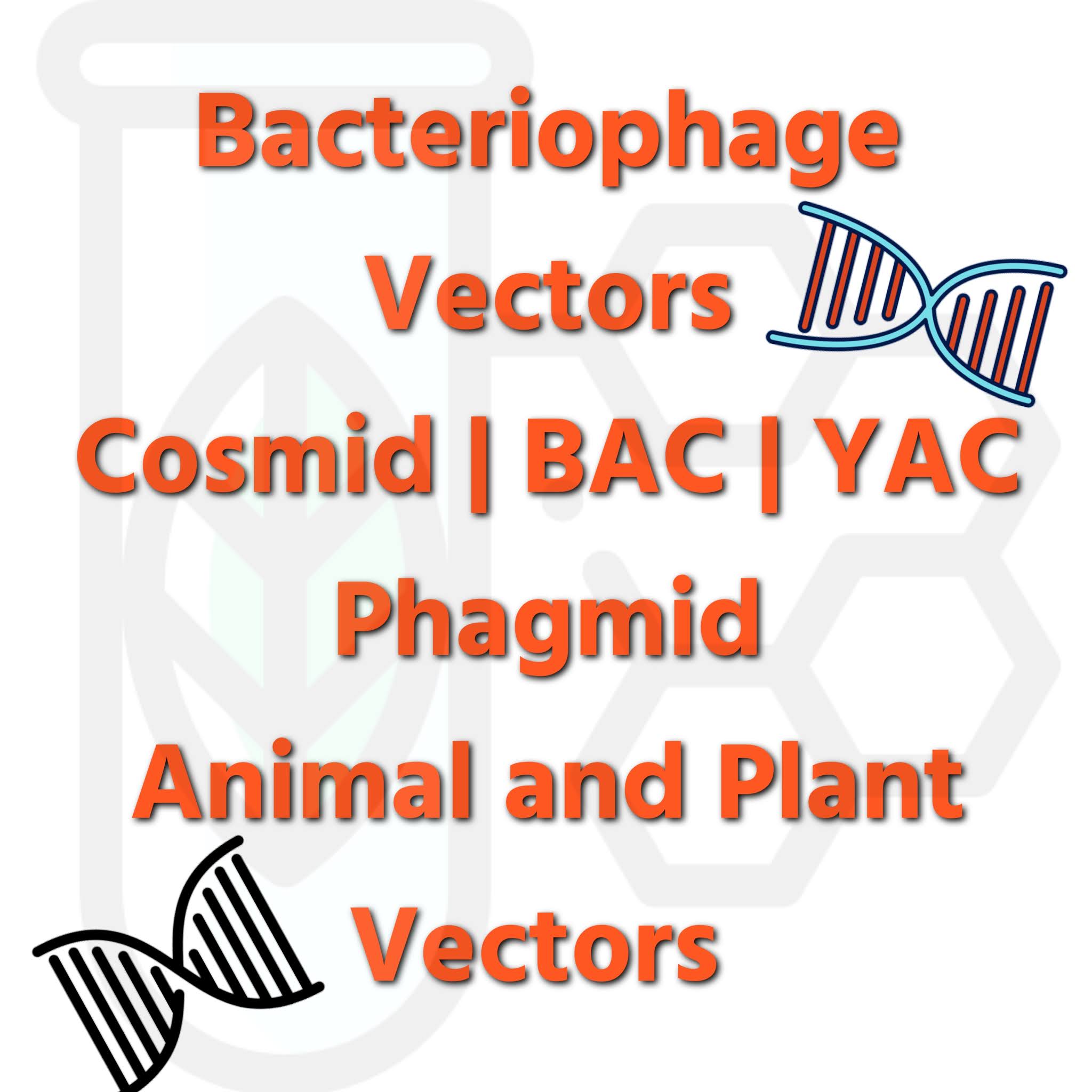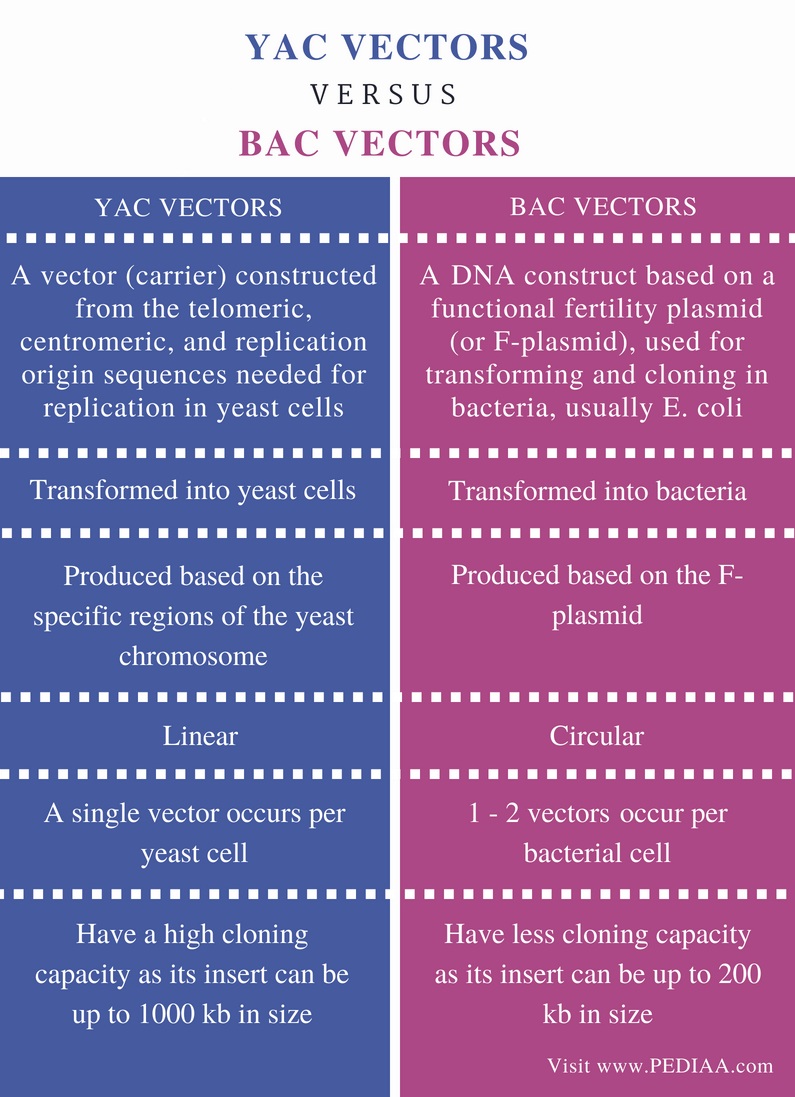
Difference Between YAC and BAC Vectors
Diagram of the TAR cloning vector pJYB. The vector contains BAC and YAC (bacterial and yeast artificial chromosomes, respectively), and polylinker cassettes. A YAC cassette contains a yeast centromere (CEN6) and a yeast selectable marker, HIS3. A BAC cassette contains the chloramphenicol acetyltransferase (CM R) gene and the F′-origin of.

HAC assembling via bacterial artificial chromosome (BAC)/yeast... Download Scientific Diagram
This video describes how bacterial artificial chromosome could be used as a cloning vector and also describes the advantage of using BAC. you must be having questions in your minds such as " How.

10 Differences between BAC and YAC Vector Major Differences
Difference between YAC and BAC Vectors A vector is a stretch of DNA that acts as a transport for carrying foreign genetic material into host cells, where it can replicate and express itself. The four types of vectors are plasmids, viral vectors, cosmids and artificial chromosomes. Vectors are constructed for different purposes.

Cosmid Vectors, YAC and BAC Expression Vectors
These BAC clones provide ∼13-fold redundant coverage of the genome and have been assembled into 376 fingerprint contigs. A yeast artificial chromosome (YAC) map was also constructed and aligned with the BAC map via fingerprinted BAC and P1 artificial chromosome clones (PACs) sharing interspersed repetitive sequence markers with the YAC-based.

Difference Between YAC and BAC Vectors YAC vs BAC Vectors
The use of YACs, BACs and PACs in transgenesis has allowed the discovery of new genes by complementation of mutations, the identification of key regulatory sequences within genomic loci that are crucial for the proper expression of genes and the design of improved animal models of human genetic diseases.

Bacteriophage Vectors Cosmid BAC YAC Phagmid Animal and Plant Vectors
Yeast artificial chromosomes or yac vector - This lecture explains about the yeast artificial chromosomes also know and the yac vector and the use of yeast a.

الفرق بين متجهات YAC و BAC الفرق بين 2023
YAC and BAC vectors are two genetically engineered artificial vectors designed to clone large DNA fragments. Now both these vectors are very much modified based on requirements. Let's differentiate the basic YAC and BAC vector in this post. Difference Between BAC and YAC Gene Cloning Vectors ||Biologyexams4u Watch on

Yeast artificial chromosome (YAC) What are the components of yeast artificial chromosome
Yeast artificial chromosomes (YACs) are genetically engineered chromosomes derived from the DNA of the yeast, Saccharomyces cerevisiae [1], which is then ligated into a bacterial plasmid. By inserting large fragments of DNA, from 100-1000 kb, the inserted sequences can be cloned and physically mapped using a process called chromosome walking.

Bacterial artificial chromosome (BAC) What is the purpose of using BAC and YAC vectors? YouTube
Artificial chromosomes have now become a major research tool in both genome analysis and in the functional characterization of genes. Yeast artificial chromosomes (YACs) (R.ef. 1; see Glossary) have led the way in mapping complex genomes, and large YAC contigs (contiguous sets of overlapping clones) now cover much of the human genome2. YACs.

Cosmid Vectors, YAC and BAC Expression Vectors
YAC and BAC vectors are two types of artificial vector systems designed to clone large genomic DNA fragments. They have multiple applications in the preparation of genomic and cDNA libraries. Key Areas Covered 1. What are YAC Vectors - Definition, Features, Construction 2. What are BAC Vectors - Definition, Features, Applications 3.

Lecture 6 January 12 2016 Biotech 3 Lecture
A bacterial artificial chromosome (BAC) is an engineered DNA molecule used to clone DNA sequences in bacterial cells (for example, E. coli). BACs are often used in connection with DNA sequencing. Segments of an organism's DNA, ranging from 100,000 to about 300,000 base pairs, can be inserted into BACs.

Different types of cloning vectors (BAC and YAC). CLONING Vectors Lecture 18 112/6/ BAC
Yeast artificial chromosomes (YACs) are genetically engineered chromosomes derived from the DNA of the yeast. It is a human-engineered DNA molecule used to clone DNA sequences in yeast cells. They are the products of a recombinant DNA cloning methodology to isolate and propagate very large segments of DNA in a yeast host.

Difference Between YAC and BAC Vectors
The procedure includes the preparation of BIBAC vectors, the preparation of clonable fragments of the desired size from the source DNA, the construction and transformation of BIBACs and, finally,.

Retrofitting of a circular YAC into a BAC containing the Neo R... Download Scientific Diagram
YAC (Yeast Artificial Chromosome) and BAC (Bacterial Artificial Chromosome) vectors are two types of cloning vectors used in molecular biology and genetics research to manipulate and study large DNA fragments, including entire genes or even entire chromosomes.
.bmp)
A brief account of YAC, BAC, HAC
Two types of vectors commonly used in cloning are yeast artificial chromosomes (YACs) and bacterial artificial chromosomes (BACs). While both serve similar purposes, there are distinct differences between them. Advertisements

Schematic representation of retrofitting a circular YAC into a BAC... Download Scientific Diagram
Yeast artificial chromosomes (YACs) have become essential research tools as they enable large fragments of DNA to be cloned. In order to overcome several disadvantages of YACs, including chimaerism and instability, several complementary bacterial artificial chromosome (BAC) vectors have been develop.